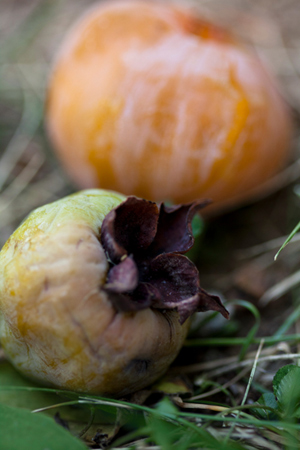By Lee McClellan
Frankfort, KY. – The cold-weather months are a good time to start wildlife habitat improvement projects in woodlands.
After the leaves are down there’s a much clearer view of the forest canopy. It’s easy to see tree crowns and the individual tree growth in relation to one another.
Start your chainsaw work in late January, after deer season closes, and finish up by mid-March, so turkeys won’t be disturbed as they begin their spring mating rituals.
 Soft mast such as these persimmons makes valuable wildlife food for deer, raccoons and other animals. Improving timber stands in late winter benefits wildlife and helps produce better hunting in the future.
Soft mast such as these persimmons makes valuable wildlife food for deer, raccoons and other animals. Improving timber stands in late winter benefits wildlife and helps produce better hunting in the future.Stands of Eastern red cedar, a species of juniper common throughout most of Kentucky, should be closely evaluated. While cedars provide cover from cold winds, this bushy evergreen is considered an invasive species in some states.
“It grows well here because it has an affinity for shallow, limestone soils,” said Stewart West, of the Kentucky Division of Forestry. “It’s a pioneer species associated with early successional habitat, but if cedars get too thick they can choke out other tree species.”
Extensive stands of 10-foot high cedars can block sunlight from reaching the ground, preventing the growth of understory vegetation. This delays the succession of trees that are more valuable to wildlife. Landowners can remedy this situation by cutting a series of small openings in stands of cedars. Pile the trees up to one side. This will create nesting cover for wild turkeys and rabbits.
Felled cedar trees can also be placed in ponds or small lakes. They make great fish attractors since cedars resist rotting.
Another practice that is beneficial to wildlife is timber stand improvement. This entails culling out unwanted trees to provide more space, sunlight and nutrients for desirable tree species. Select a favored tree and cut away competing vegetation. The favored tree should be one of the tallest trees in the area with a healthy crown that exhibits strong mast production.
Large trees competing for space with more desirable species don’t need to be felled. They can be girdled or killed on the stump by making a 2-inch deep cut with the chainsaw all the way around the tree trunk.
Protecting oak trees should be the highest priority since acorns are the preferred hard mast for deer, turkey and other wildlife species. It takes 20 years for an oak tree to start producing acorns. A closed-forest canopy that gives full shade is detrimental to the regeneration of oaks and other beneficial tree species.
Soft mast, such as berries and fruits produced by trees, is an important wildlife food that ripens in late summer and early fall, before hard mast, such as acorns, matures. Wildlife also eat the nuts and seeds produced by hickory, walnut, beech, hackberry, white ash and cherry trees.
As the forest canopy closes over time, the productivity of soft mast trees declines.
“The trees and shrubs that produce soft mast need sunlight to set fruit,” said Steve Bonney, a wildlife biologist with the Kentucky Department of Fish and Wildlife Resources. “Persimmon trees, for example, are often found in fence rows or along field edges because they need full sun to consistently produce fruit.” When fully ripe their orange fruit is a favorite of deer, raccoon and opossum.
Other trees and shrubs that produce soft mast include sumac, hawthorn, viburnum, black gum, wild plum and flowering dogwood.
“Black gum, found throughout Kentucky and common in the eastern mountains, is an early fruit producer,” said Bonney. “A large sweet gum is a valuable tree. When the tree is full of berries, it’s a magnet for grouse and songbirds.”
While all trees serve a purpose in nature, some are not as important to wildlife. It is tolerable to remove a few species of trees such as sycamore, black locust, elm, maple and box elder.
“I would try to avoid removing cavity trees,” said Bonney, “especially large sycamores along creeks. Squirrels, furbearers and wood ducks often nest in big trees with cavities (den holes).”
Winter is also a good time to place nest boxes, if cavity trees are limited.
Where possible, it’s a good idea to cut lanes or trails through woodlands to provide access in case of wild fire. If there’s adequate sunlight reaching the forest floor, trails can be disked and planted in clover. Trails come in handy during hunting season, too, for quietly accessing hunting areas.
Use the winter season to conduct some timber stand improvement and benefit wildlife in the process.
Author Art Lander Jr. has been writing about the outdoors since the 1970s. He is a staff writer for Kentucky Afield Magazine.
Media Contact: Lee McClellan 1-800-858-1549, ext. 4443


Be the first to comment